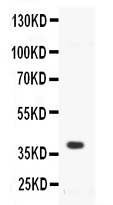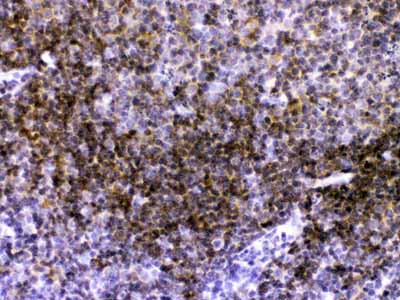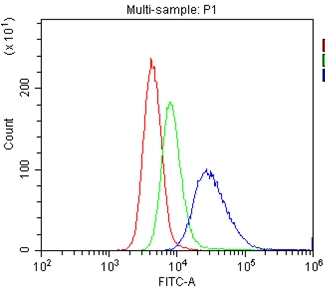Anti-CD40/TNFRSF5 Picoband Antibody
- SPECIFICATION
- CITATIONS
- PROTOCOLS
- BACKGROUND

Application
| WB, IHC-P, IHC-F, FC, ICC, E |
|---|---|
| Primary Accession | P27512 |
| Host | Rabbit |
| Reactivity | Human, Mouse |
| Clonality | Polyclonal |
| Format | Lyophilized |
| Description | Rabbit IgG polyclonal antibody for Tumor necrosis factor receptor superfamily member 5(CD40) detection. Tested with WB, IHC-P, IHC-F, ICC, ELISA, FCM in Human;Mouse. |
| Reconstitution | Add 0.2ml of distilled water will yield a concentration of 500ug/ml. |
| Gene ID | 21939 |
|---|---|
| Other Names | Tumor necrosis factor receptor superfamily member 5, B-cell surface antigen CD40, Bp50, CD40L receptor, CD40, Cd40, Tnfrsf5 |
| Calculated MW | 32093 MW KDa |
| Application Details | Immunohistochemistry(Paraffin-embedded Section), 0.5-1 µg/ml, By Heat Immunohistochemistry(Frozen Section), 0.5-1 µg/ml Immunocytochemistry, 0.5-1 µg/ml ELISA , 0.1-0.5 µg/ml Western blot, 0.1-0.5 µg/ml Flow Cytometry, 1-3μg/1x106 cells |
| Subcellular Localization | Isoform I: Cell membrane; Single-pass type I membrane protein. |
| Protein Name | Tumor necrosis factor receptor superfamily member 5 |
| Contents | Each vial contains 5mg BSA, 0.9mg NaCl, 0.2mg Na2HPO4, 0.05mg NaN3. |
| Immunogen | E. coli-derived mouse CD40/TNFRSF5 recombinant protein (Position: L20-R193). Mouse CD40/TNFRSF5 shares 60.7% amino acid (aa) sequence identity with human CD40/TNFRSF5. |
| Purification | Immunogen affinity purified. |
| Cross Reactivity | No cross reactivity with other proteins |
| Storage | At -20˚C for one year. After r˚Constitution, at 4˚C for one month. It˚Can also be aliquotted and stored frozen at -20˚C for a longer time.Avoid repeated freezing and thawing. |
| Name | Cd40 |
|---|---|
| Synonyms | Tnfrsf5 |
| Function | Receptor for TNFSF5/CD40LG (By similarity). Transduces TRAF6- and MAP3K8-mediated signals that activate ERK in macrophages and B cells, leading to induction of immunoglobulin secretion (PubMed:12881420). |
| Cellular Location | [Isoform I]: Cell membrane; Single-pass type I membrane protein [Isoform IV]: Cell membrane; Single-pass type I membrane protein [Isoform II]: Secreted. |

Thousands of laboratories across the world have published research that depended on the performance of antibodies from Abcepta to advance their research. Check out links to articles that cite our products in major peer-reviewed journals, organized by research category.
info@abcepta.com, and receive a free "I Love Antibodies" mug.
Provided below are standard protocols that you may find useful for product applications.
Background
Carbonic anhydrase III (CA3) is an enzyme that in humans is encoded by the CA3 gene. CA3 is a member of a multigene family (at least six separate genes are known) that encode carbonic anhydrase isozymes. The gene spans 10.3 kb and contains seven exons and six introns. Using a cDNA clone of the CA3 gene in the study of human-rodent hybrids, the gene was mapped to chromosome 8 which carries a cluster of CA genes. The expression of the CA3 gene is strictly tissue specific and present at high levels in skeletal muscle and much lower levels in cardiac and smooth muscle. A proportion of carriers of Duchenne muscle dystrophy have a higher CA3 level than normal.
If you have used an Abcepta product and would like to share how it has performed, please click on the "Submit Review" button and provide the requested information. Our staff will examine and post your review and contact you if needed.
If you have any additional inquiries please email technical services at tech@abcepta.com.













 Foundational characteristics of cancer include proliferation, angiogenesis, migration, evasion of apoptosis, and cellular immortality. Find key markers for these cellular processes and antibodies to detect them.
Foundational characteristics of cancer include proliferation, angiogenesis, migration, evasion of apoptosis, and cellular immortality. Find key markers for these cellular processes and antibodies to detect them. The SUMOplot™ Analysis Program predicts and scores sumoylation sites in your protein. SUMOylation is a post-translational modification involved in various cellular processes, such as nuclear-cytosolic transport, transcriptional regulation, apoptosis, protein stability, response to stress, and progression through the cell cycle.
The SUMOplot™ Analysis Program predicts and scores sumoylation sites in your protein. SUMOylation is a post-translational modification involved in various cellular processes, such as nuclear-cytosolic transport, transcriptional regulation, apoptosis, protein stability, response to stress, and progression through the cell cycle. The Autophagy Receptor Motif Plotter predicts and scores autophagy receptor binding sites in your protein. Identifying proteins connected to this pathway is critical to understanding the role of autophagy in physiological as well as pathological processes such as development, differentiation, neurodegenerative diseases, stress, infection, and cancer.
The Autophagy Receptor Motif Plotter predicts and scores autophagy receptor binding sites in your protein. Identifying proteins connected to this pathway is critical to understanding the role of autophagy in physiological as well as pathological processes such as development, differentiation, neurodegenerative diseases, stress, infection, and cancer.




